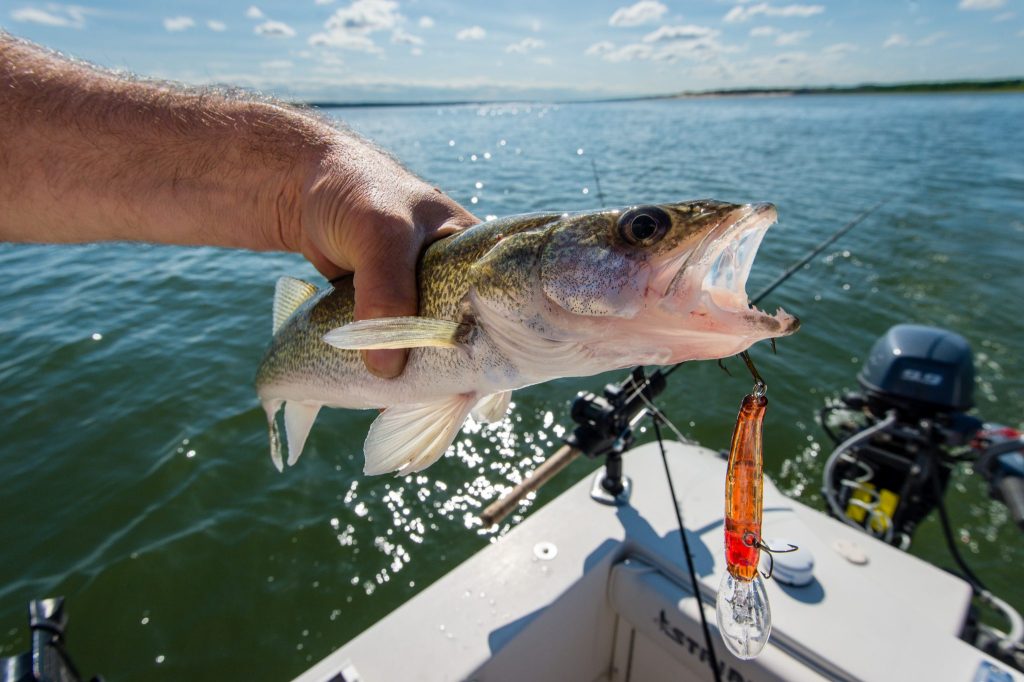New program offers improved survival rates, catch rates for walleye.
Enlarge

Story by Cara Pesek
For years, Game and Parks biologists have stocked walleye fingerlings in popular lakes and reservoirs across the state. Results have been mixed, with some waters yielding major benefits and others seeing poor survival. Southeastern Nebraska reservoirs fall into the latter category, where there has been limited success in building robust walleye populations, especially in waters with established largemouth bass populations.
But a new way of raising walleyes for stocking is changing that, said Jim Gleim, Nebraska Game and Parks Commission’s assistant division administrator for fish production. This new method has resulted in greater survival rates for stocked walleye, and better walleye catch rates for anglers.
The process is time-intensive and involves feeding young walleye a lot of minnows – about 3.5 pounds of minnows for every pound of walleye raised, Gleim estimated. It took hatchery staff years to perfect the process, which they began experimenting with back in the 1990s, and then revived and finessed in 2013.
This is how the process works: During walleye spawn in April, eggs are collected from Sherman Reservoir, Merritt Reservoir and Lake McConaughy. The eggs are incubated at the hatcheries at North Platte and at Calamus and hatch after about two weeks. A week or so after hatching, various lakes and reservoirs around the state are stocked with fry. Some of the fry remain in the hatcheries and are stocked in other lakes and reservoirs in early June, as 1.4-inch fingerlings.
A portion of those fingerlings remain at the hatcheries for the summer and into the fall. The walleye fingerlings feed on zooplankton in hatchery ponds, at least until that food source is diminished and they need something more substantial.
Enter the minnows. As the fingerlings are feeding on zooplankton, Game and Parks staff get ready for the next step, stocking each of several ponds with 50 pounds of fathead minnows. These brood minnows spawn and produce a huge crop of 1-inch minnows, which become the feed for the young walleye, starting in late June.

It takes the walleye about a month to eat all those minnows. After that, they are fed wholesale bought fathead minnows every other week until stocking. Between late July and the first week of October, when the walleye leave their hatchery ponds for their news homes in lakes and reservoirs across the state, they will have grown to an average length of 8.1 inches.
In fisheries biologist lingo, these large, minnow-fed walleye are known as “advanced walleye.” Since the advanced walleye program was revived in 2013, biologists have stocked 21 lakes and reservoirs, mostly in southeastern Nebraska, with advanced walleye.
“We’re seeing a lot better survival, and that’s mainly because they’re stocked larger, and they’re much better able to avoid predation,” said Game and Parks fisheries biologist Tony Barada. “These fish are at least two to three times more likely to survive to age one and age two compared to fingerling stockings, and in many reservoirs here in southeastern Nebraska we are creating walleye fisheries where we would have almost no chance if we only had the capabilities of stocking 1-2 inch fish.”
Angler surveys at Pawnee Lake and Lake Wanahoo have shown increased catch rates since the advance walleye stocking program was introduced. Barada and his colleagues also used an online approach developed by University of Nebraska researchers to gauge angler behavior and interest associated with the stocking program. They looked at mentions of walleye on social media channels and other online platforms and found an increase in the number of mentions of walleye near areas where the fish had been stocked.
Game and Parks staff have begun raising advanced northern pike, muskie and saugeye, using similar production methods, Barada said. They are seeing good survival rates and increased catch rates for those species, too.
The advanced walleye program, along with the advanced pike, muskie and saugeye programs, are still relatively new and haven’t been widely publicized. While die-hard anglers have kept track of the advanced fish stockings, more casual anglers who venture out on the water where these species have been stocked may be in for a pleasant surprise.
“People pull up to a lake and have no idea that there’s walleye in it,” Barada said. “We want to get the word out about these opportunities.” ■
Walleye Stocking
This fall, Game and Parks expects to stock more than 30,000 advanced walleye in lakes and reservoirs across the state. Stockings are scheduled for the following lakes and reservoirs:

• Swanson Reservoir
• Buckskin Hills
• Powder Creek Reservoir
• Skyview Lake
• War Axe
• Mormon Island West
• Sandy Channel #8
• Cottonmill Lake
• GI L.E.Ray Lake
• Branched Oak
• Wagon Train
• Yankee Hill
• Burchard Lake
• Czechland Lake
• Wildwood
• Lake Wanahoo
• Wehrspann Lake
• Prairie Queen
• Lawrence Youngman Lake
• Zorinsky Lake
• Walnut Creek
• Holmes Lake
The post How to Raise Big Walleye appeared first on NEBRASKALand Magazine.
















